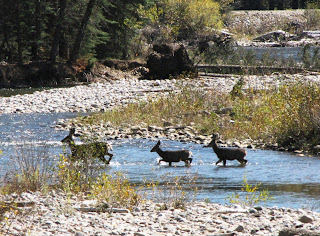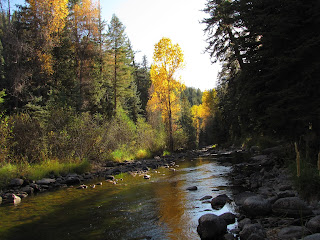I
mean no disrespect to call these grounds truly sacred, in the Native
American sense, so the Ancient Puebloans of Colorado should forgive
me. The designation of “sacred” bears heavier meaning and
importance for these folks. I call them sacred
solely because the incredible feeling of piety and respect that they
instilled in me.
Like
any national park I have seen so far, the true beauty of Mesa Verde
is hidden. There is no way to drive by it, on the highway, and to see
the real true beauty that springs at every corner, and most
importantly the many years of history that it stores like a well-kept
secret. In many ways, though, Mesa Verde is like no other Park I have
seen before, nor like many to come, I am sure.
You
drive up a steep paved road to the Visitors' Center first. The
Visitors' Center building is built out or the yellow sandstone rock
that the mountains in the Four Corners are known for. The building
reminded me of the American Native Museum in DC –
http://wander-world.blogspot.com/2005/07/days-trip.html.
The rounded walls and a feeling of ever flowing are the main
characteristics of it. The soft yellow color of the stones wraps
around you like a warm blanket.
After
the Visitors' Center (if you don't want to walk through the actual
abodes in the pueblos, you don't need to queue up in line for a
ticket. The driving tour alone is paid at the entrance into the park
which is a bit higher than the Center), we started on the 20+ mile
journey into the park, to look for its natural beauty and for the man
(or woman) made pueblos that made this park famous.
We
drove quite a bit, stopping on overlooks that opened up into the vast
Mancos Valley below. The tall Colorado mountains, dressed in snow (a
bit early for early October) guarded the horizon, making sure the
valley won't overflow into the sky.
Colorado
is the state with the most tall mountains in the US. It has 53 of the
100 tallest mountains in the land. And you can certainly see it and
feel it. There are no places I have ever driven to in Colorado that
won't force you to drive past a pass of some description. The views
from everywhere were wide open and breathtaking. The big, openness of
the land out here, with the never ending feeling is what's amazing
about The American West. It speaks to the “last frontier” concept
– it truly feels like there is either nothing or everything beyond
it.
I
think we drove maybe 20 miles before we saw our first Pueblo – the
Cliff Palace. We stopped for the overlook, and we walked down a
narrow and somewhat steep paved trail, and we reached a landing over
the Navajo Canyon. My husband gasped: “Aahh! Bring me here!
I'll pass on the Grand Canyon!” I have not seen the latter, so I
cannot be the judge, but the view was once again spectacular. But …
we were puzzled. The small pueblo across the canyon from us was not
as impressive as the pictures had shown the Cliff Palace. Then we
realized: it was behind us, and below us. Once I turned around and
saw it, it literally knocked the breath out of my lungs!
The Cliff Palace pueblo was probably a place for worship, socializing, or coming together in some way. It is the largest pueblo in Mesa Verde.
You're
towering over these 700 year old ruins and your mind just stops in
its tracks, really. You can see vestiges of old rooms, their
interconnection, their infrastructure, you can tell where the hearth
was and where the windows were, clearly. Where they had multiple
levels and where they dug under the ground, as if to dig up a
basement. That's 700 years ago. With little tools, but much
determination, drive and know-how.
I
have been in America for 18 years now, and I have never met anyone
that talked about these testimonies of time. The first thing
Americans tells me, as an immigrant is that they expect me to know
and respect the “American culture”. But they mean the
Thanksgiving turkey and baseball, really. Not one of them has ever
talked about this.
It makes me wonder if they (as immigrants by descent) know their
culture, too. This is where America starts.
You
are blown away to learn the history behind these dwellings. I am sure
you can (if you wish) google all the information you need to know
about these places. But I just wanted to give an account of what I
saw, and felt here. Apparently, the pueblos date as far back as 300
AD, and they were built and populated all the way into 1300 AD. This
is the time between Constantine the Great and The Crusades, in
Europe, just to give you perspective. It was humbling, to see such
intricate architecture, such solid foundations and ingenuity from
people that seemingly were not open to the “civilization” of the
rest of the world at that time. They had not seen the baths of Rome
or the Temples of Greece, or the Asian pagodas. But they had created
out of stone, with their bare hands, their own villages that looked
just as stunning in functionality and purpose.
There
is a beauty all its own in Mesa Verde: you're not sure what's more
amazing, the land, or the people's work?! I'd say the truth is in the
middle.
Nature
reigns supreme in The Park, like you'd expect: steep canyons,
crooked, old juniper trees, layers and layers of many kinds of rocks,
the usual archaeological rainbow on the South West, wild turkeys,
deer, and coyotes walking in broad daylight, unperturbed by traffic
and human presence, they all welcome you in their midst. But then,
there is the amazing perfection and beauty left by the people. Like
precious accessories on a beautiful dress, the pueblos dot the valley
in a beautiful, artful kaleidoscope.
Apart
from being amazing builders and planners, the ancients puebloans had
a sense of geography (they almost always built their homes facing the
South, to soak in the sunshine) and functionality. They used the
natural caves for some of the walls of their homes. The “House with
many windows” construction is a testament of that – the entire
house is sandwiched between two rocks (top and bottom), with an
exterior wall uniting them on the outside. There are windows carved
inside this exterior wall. All the other pueblos are like this: some
carved into the natural stone that was there, and some built by
people.
"House with many windows"
It
was amazing to me how they built these massive abodes with almost
perfect bricks. They didn't make bricks, they just cut rock in square
or rectangular shapes, smoothed them over with other rocks, and
stacked them together using sand and water mixed together for their
mortar. The walls are so smooth, whether they are a perfect circle or
they built a square building, or room.
My personal favorite pueblo: The Square Tower
Another
surprising thing was that not only did they built at very high
elevations (their trails were vertical, we were told), directly into
the wall of the canyons, but they also built multi-level buildings.
"Vertical trails" - the bronze statue at the Visitors' Center suggests just that
Your
head explodes with questions, as you're seeing all these homes,
places of ritual, or grain silos: how did they climb this high? How
did they walk up and down these steep rocks with their bare feet and
sometimes a huge load in their hands, or on their bodies? How did
they get water? How did they keep warm in this rocky terrain? How did
they have their babies, with no doctor around? How did they survive
for 900 years in these parts?! You learn that drought is what made
them leave this behind and migrate to New Mexico and Arizona, in
greener places, but the fact that they lived here, in this terrain
for 900 years is still mind boggling.
Then,
you stand still and listen. You almost can hear the sounds and voices
of many hundreds of years past. Were there any love affairs? Any
feuds? Any passions? Babies crying; women singing; men sharpening
rocks. You smell fresh kill roasting in the fire and hear corn boil
in water. You close your eyes and are transposed. An odd feeling of
guilt and shame mixed in with humility and gratefulness simmers in
the chest. So much humanity, so much life, never put into written
words somewhere, buried with the centuries in old sandstone.
Then,
we went to the museum, in Mesa Verde, and the next day to the Anasazi
Heritage Center and learned more about their various stages in
history: before basket weaving, and after, all the way into the
pottery era. Every stone exposed, every basket, every rudimentary
tool gave me the same feeling that I have had in my life when praying
in church, or at a Saint's altar. It belittled me. This is how this
world started, here in the West. The idea of the white people
diminishing this and killing part of this culture made my hair stand
on my back with rage, at times.
We
left the area moved and deep in silence and in thought. So grateful,
and so rich! I looked for books to read about this culture, because I
want to know more, and feel more connected to these beautiful
surroundings I almost live next door to.
No
other National Park has left me with more questions in my head than
answers, like Mesa Verde. It opened the door not only to a new
universe, but into a new and old world, full of mysteries and
stories. I definitely plan to go back, or at the very least to read
more about these hidden gems, tucked away for centuries (it was in
the late 1800's that they were finally discovered). History, life,
architecture, love, politics, farming, cooking, hunting - all opening
up into the canyons of Mesa Verde – opened a new curiosity in my
heart and mind. I feel more “American” now than ever before,
because this earth has spoken to me.
Quotation at the entrance of the Anasazi Heritage Center. Click on the picture for more photos from this amazing journey


































